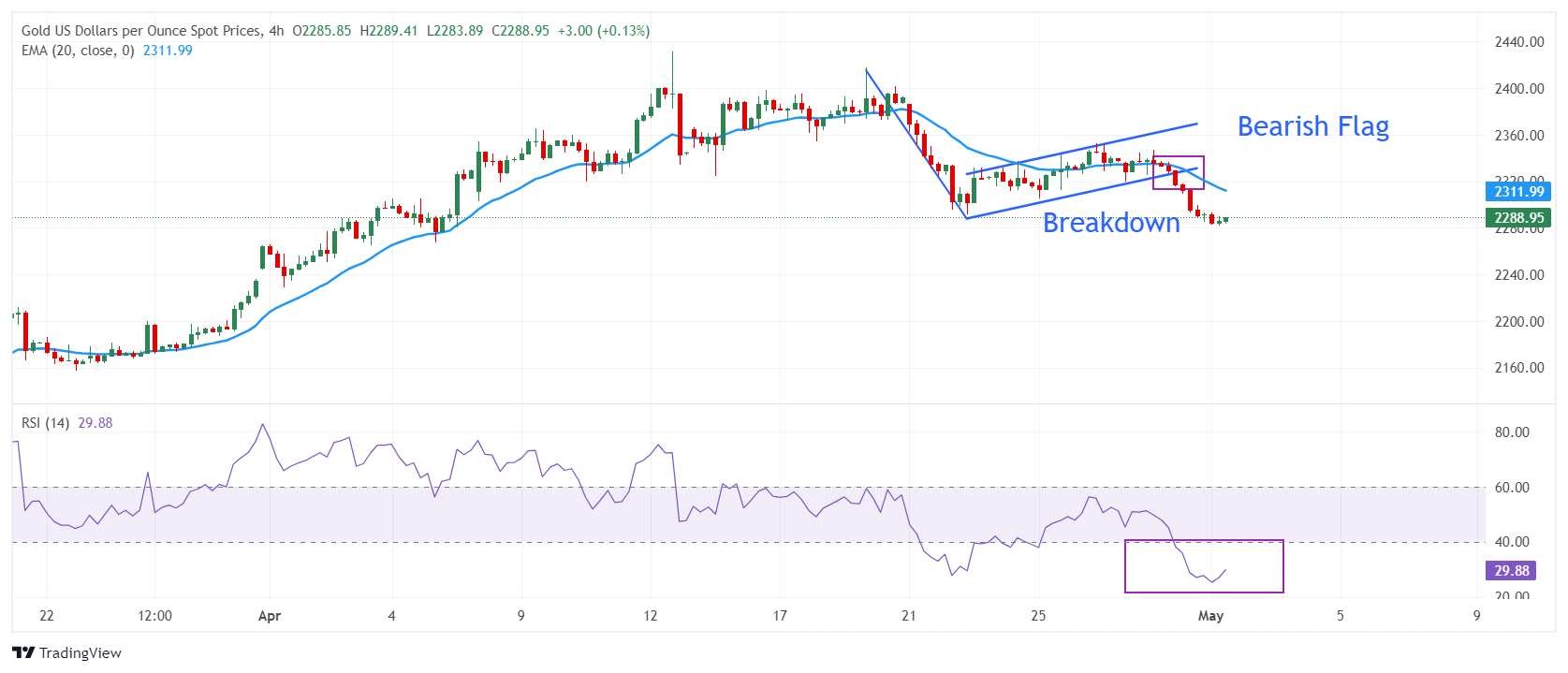- Gold price hovers below $2,300 as uncertainty ahead of the Fed’s policy announcements improves the appeal of the US Dollar and bond yields.
- The Fed is expected to support keeping interest rates at their current levels for a longer period.
- The strong US Q1 Employment Cost Index adds to evidence of the stubborn inflation outlook.
Gold price (XAU/USD) trades close to a more than three-week low around $2,285 in Wednesday’s early New York session. The precious metal weakens as the US Dollar and bond yields strengthen amid firm speculation that the Federal Reserve (Fed) will opt for maintaining a restrictive interest rate environment for a longer period due to inflation remaining persistently higher than expected in the first quarter of the year.
In this context, 10-year US Treasury yields move higher to 4.69%. The US Dollar Index (DXY), which tracks the US Dollar’s value against six major currencies and is negatively correlated to the Gold price, jumps to a two-week high of around 106.50. The US Dollar remained on the backfoot last week after weak growth in Q1 Gross Domestic Product (GDP) raised concerns over the country’s economic outlook. However, it bounced back strongly on Tuesday after the US Bureau of Economic Analysis (BEA) reported strong Q1 Employment Cost Index numbers.
Meanwhile, the appeal for the US Dollar has further improved as the ADP Employment Change for April has surprisingly turned out upbeat. The ADP agency showed that US private employers hired 192K job-seekers, higher than the prior reading of 184K. Investors forecasted a slight decline to 175K.
Daily digest market movers: Gold price sees more downside on surprisingly upbeat US Employment Change
- Gold price falls sharply, below the crucial support of $2,285, on expectations that the Federal Reserve will maintain a hawkish guidance on interest rates in its monetary policy meeting after keeping interest rates steady in the range of 5.25%-5.50% for the sixth straight time.
- A slew of hotter-than-expected inflation readings so far this year indicate that the disinflation process has stalled. It suggests that the Fed should keep interest rates high for a longer period until policymakers gain confidence that price pressures will sustainably return to the desired rate of 2%. Also, the strong US Q1 Employment Cost Index is another indication that price pressures remained hot in the January-March period. The index is generally driven by a strong wage growth environment in which labor demand remains strong, which rose by 1.2% in the first quarter, against the consensus of 1.0% and the prior reading of 0.9%.
- Prospects of interest rates remaining higher bode poorly for Gold as it increases the opportunity cost of holding an investment in it. Meanwhile, investors are keen to know about rate-cut timing and the current status of the Fed’s three rate-cut projections, indicated by March’s dot plot. The CME FedWatch tool shows that traders see the Fed begin reducing interest rates from the September meeting.
- In Wednesday’s session, investors will also focus on the ISM Manufacturing PMI data for April will be published in the early New York session before the Fed’s interest rate decision. The Manufacturing PMI is estimated to have dropped to 50.0 from 50.3 in March.
- From the Manufacturing PMI report, investors will keenly focus on the New Orders subcomponent. The preliminary PMI survey by S&P Global for April reported that output growth cooled in line with demand weakness as new orders decreased for the first time in six months, albeit dropping only modestly. Falling new business was signalled among manufacturers and service providers alike. Upbeat employment and factory data would improve the US economic outlook, while weak numbers will deepen concerns over a slowdown.
Technical Analysis: Gold price slips below $2,300

Gold reported steep losses after a breakdown of the Bearish Flag formation in the four-hour time frame. The Bearish Flag formation demonstrates a consolidation move after a sharp correction, generally following the ongoing trend. The near-term outlook is bearish as the Gold price is trading below the 20-period Exponential Moving Average (EMA), which is at $2,312.
On the downside, March 23 high at $2,223 will be the major support for the Gold price. The 14-period Relative Strength Index (RSI) oscillates in the bearish range of 20.00-40.00, suggesting that momentum has leaned towards bears.
Employment FAQs
Labor market conditions are a key element to assess the health of an economy and thus a key driver for currency valuation. High employment, or low unemployment, has positive implications for consumer spending and thus economic growth, boosting the value of the local currency. Moreover, a very tight labor market – a situation in which there is a shortage of workers to fill open positions – can also have implications on inflation levels and thus monetary policy as low labor supply and high demand leads to higher wages.
The pace at which salaries are growing in an economy is key for policymakers. High wage growth means that households have more money to spend, usually leading to price increases in consumer goods. In contrast to more volatile sources of inflation such as energy prices, wage growth is seen as a key component of underlying and persisting inflation as salary increases are unlikely to be undone. Central banks around the world pay close attention to wage growth data when deciding on monetary policy.
The weight that each central bank assigns to labor market conditions depends on its objectives. Some central banks explicitly have mandates related to the labor market beyond controlling inflation levels. The US Federal Reserve (Fed), for example, has the dual mandate of promoting maximum employment and stable prices. Meanwhile, the European Central Bank’s (ECB) sole mandate is to keep inflation under control. Still, and despite whatever mandates they have, labor market conditions are an important factor for policymakers given its significance as a gauge of the health of the economy and their direct relationship to inflation.

























